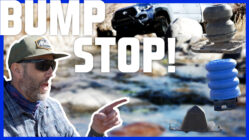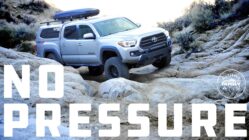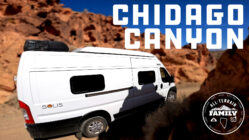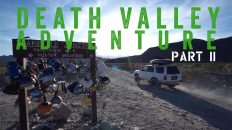Number 1: Titus Canyon
From The Death Valley Road there Titus Canyon road crosses the Amargosa valley and ascends to Red Pass. The road is one-way into the park here so you don’t have to worry about oncoming traffic on this steep shelf road.
Once you get over Red Pass the road descends into the ghost town of Leadfield where you’ll find some ruins of the mine and townsite. This is a good place to stop for lunch and a walk among the derelict structures.
As you continue on the road heads into the wash and enters Titus Canyon. It’s slow going as the road meanders through the steep rock walls. There are places to stop off the road and enjoy climbing on the walls of the box canyon. Just when you think it’ll pinch off entirely, it opens up to the wide valley of Mesquite Flat.
On this side of the canyon there is a parking area where park visitors can hike up the road into Titus Canyon. But you can’t drive into the canyon without going back around to the other end.
The road ends at the paved North Death Valley Highway and you can head south to the main part of the park, or but I recommend heading North.
Number 2: Ubehebe Crater
Ubehebe crater is one of the northern most attractions at Death Valley National Park and lies at the end of the paved road. There’s plenty of parking, but no services. Ubehebe crater is a Maar volcano that is 600 feet deep, a half mile across and is surrounded by miles of red and black cinders. You can hike into the crater, as well as around the perimeter to see views of the surrounding mountains and several other smaller craters. I recommend planning to spend several hours here hiking around if you can. When we were there we had a napping baby and high winds that got us moving along far too soon.
From the Ubehebe Crater parking area you can access the Racetrack Valley Road. This is where you’ll definitely want to air down your tires as the 30 mile trip to Racetrack Valley is extremely rough and washboarded.
Number 3: Racetrack Playa
The road into racetrack valley is spectacular and once you leave the Ubehebe Crater area, you are heading of into the some of the most remote and rugged areas of the park. There are no services and from here on you’ll be seeing fewer and fewer other travelers. As you travel south from Ubehebe Crater you head up and over a pass and then descend down into Racetrack Valley. The first thing you come to of interest is Teakettle Junctio. In the distant past a teakettle was hung from the sign to indicate the presence of a water source nearby. Don’t expect to find any water today though. As you proceed down to the south end of the valley you’ll find Homestake Dry Camp with a dozen camp sites, and no other services.
After you set up camp, head back down to Racetrack Playa, home of the mysterious moving stones. As you walk out in the surface of this flat, dry lakebed you’ll find rocks from the surrounding mountain ranges far out in the middle of the playa with trails of wake behind them. How did they get there? The world may never know…
From Racetrack Playa, there are a number of routes out, the coolest by far is Lippencott Mine road.
Number 4: Lippencott Mine Road
After a gentle rise out of Racetrack Valley, Lippencott Mine Road descends 2000 feet down to Saline Valley. The road is steep, rocky and loose with tight switchbacks and steep drop-offs.
Lippencott Mine road is a serious road that shouldn’t be taken lightly. While it’s not a technical challenge for most vehicles, taking it slow, in low range and 4 wheel drive is a good idea. You don’t want to be going too fast, or riding your brakes with consequences like these.
There are rough rocky sections, tight switchbacks, and narrow sections with treacherous washouts that demand your careful attention.
Soon enough, the road mellows out as you enter the peaceful Saline Valley below. Lippencott Road heads down into the valley and intersects with Saline Valley Road. From here, head north to Saline Valley Warm Springs. There you’ll find campsites, and ample weirdness. If you want to avoid that, head up Steel Pass Road past all that to Upper Warm Spring, with two warm spring pools and two Palm Trees and plenty of space for camping.
In the morning you can head on up the road towards Steel Pass and Dedeckera Canyon.
Number 5: Dedeckera Canyon
Of all the roads described in this video, this one is the most technical and remote. On one end, Saline Valley is remote and hard to get to, and on the other end, Eureka Dune is remote, and hard to get to. Two of the least visited areas of the park, and this is the hardest way to get from one to the other. So take care and be prepared.
From Salaine Valley, Steele Pass Road heads up the wash and is only sometimes a defined road, and other times is just a river bed. Nothing here is particularly challenging, but there are plenty of bumps and reasons to be in 4 wheel drive.
Once you crest Steele Pass the road backs off a bit before heading into Dedeckera Canyon, where things get tight again. The main challenge here is this tight rock canyon with two waterfalls and some rocky sections. Our stock 4Runners made it no problem, but smaller, and larger vehicles may encounter difficulties with the rock steps and narrow canyon walls.
This road can be run from either direction. Here’s a stock 4Runner driving it from the other end. Heading from Eureka to Saline is definitely more adventurous, but it you aren’t sure about you can make it, give it a look from this end first. If you can make it past Dedeckera, then it’s smooth sailing all the way to Saline.
BONUS #1 Eureka Dune
If you have time, Eureka Dune is a great place to camp and explore the dune. Eureka Dune is the tallest sand dune in North America. It rises 680 feet above the valley floor. While surrounded by a dispersed camping area, the dune is off limits to vehicles and there are no services here at all. Definitely stay for a hike on the dune, though this is only really possible in the spring or fall as the heat here can be intolerable in summer. In years past we visited in fall when it was nice and cool and the sand was wet making is much easier to hike to the top.
While Eureka Dune is approachable in non-4×4 vehicles, do be aware that the farther down the road you go, the deeper the sand gets. We stopped to help a couple who had bogged their camper in the sand. Using my snatch strap I was able to yank it out and tow it back onto the packed sand of the road.
Bonus #2: Bailey’s Hot Spring
If you are entering Death Valley from the East, check out Bailey’s Hot Spring in Beatty, Nevada. While there isn’t a lot of tent camping here, there are plenty of Trailer, RV or Root-Top-Tent sites. There are showers and bathrooms and two hotspring pools for visitors to soak. When we were there we spent a lot of time playing with the baby goats at the little farm the owners operate on the property. We could have spent the whole day there for sure.











Add comment